ECO mode FORD RANGER 2023 Owner's Manual
[x] Cancel search | Manufacturer: FORD, Model Year: 2023, Model line: RANGER, Model: FORD RANGER 2023Pages: 470, PDF Size: 13.06 MB
Page 166 of 470
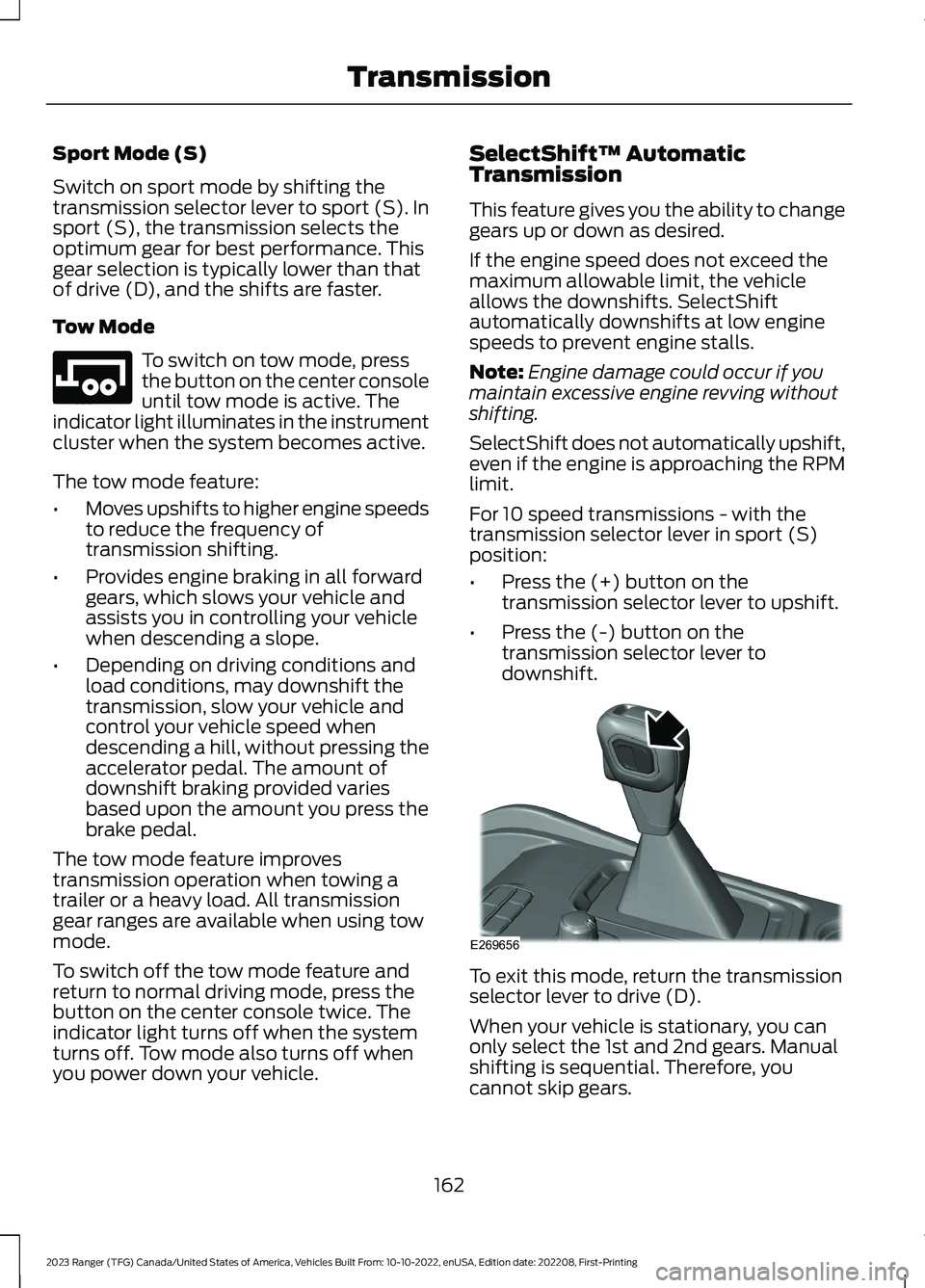
Sport Mode (S)
Switch on sport mode by shifting thetransmission selector lever to sport (S). Insport (S), the transmission selects theoptimum gear for best performance. Thisgear selection is typically lower than thatof drive (D), and the shifts are faster.
Tow Mode
To switch on tow mode, pressthe button on the center consoleuntil tow mode is active. Theindicator light illuminates in the instrumentcluster when the system becomes active.
The tow mode feature:
•Moves upshifts to higher engine speedsto reduce the frequency oftransmission shifting.
•Provides engine braking in all forwardgears, which slows your vehicle andassists you in controlling your vehiclewhen descending a slope.
•Depending on driving conditions andload conditions, may downshift thetransmission, slow your vehicle andcontrol your vehicle speed whendescending a hill, without pressing theaccelerator pedal. The amount ofdownshift braking provided variesbased upon the amount you press thebrake pedal.
The tow mode feature improvestransmission operation when towing atrailer or a heavy load. All transmissiongear ranges are available when using towmode.
To switch off the tow mode feature andreturn to normal driving mode, press thebutton on the center console twice. Theindicator light turns off when the systemturns off. Tow mode also turns off whenyou power down your vehicle.
SelectShift™ AutomaticTransmission
This feature gives you the ability to changegears up or down as desired.
If the engine speed does not exceed themaximum allowable limit, the vehicleallows the downshifts. SelectShiftautomatically downshifts at low enginespeeds to prevent engine stalls.
Note:Engine damage could occur if youmaintain excessive engine revving withoutshifting.
SelectShift does not automatically upshift,even if the engine is approaching the RPMlimit.
For 10 speed transmissions - with thetransmission selector lever in sport (S)position:
•Press the (+) button on thetransmission selector lever to upshift.
•Press the (-) button on thetransmission selector lever todownshift.
To exit this mode, return the transmissionselector lever to drive (D).
When your vehicle is stationary, you canonly select the 1st and 2nd gears. Manualshifting is sequential. Therefore, youcannot skip gears.
162
2023 Ranger (TFG) Canada/United States of America, Vehicles Built From: 10-10-2022, enUSA, Edition date: 202208, First-PrintingTransmissionE246592 E269656
Page 169 of 470
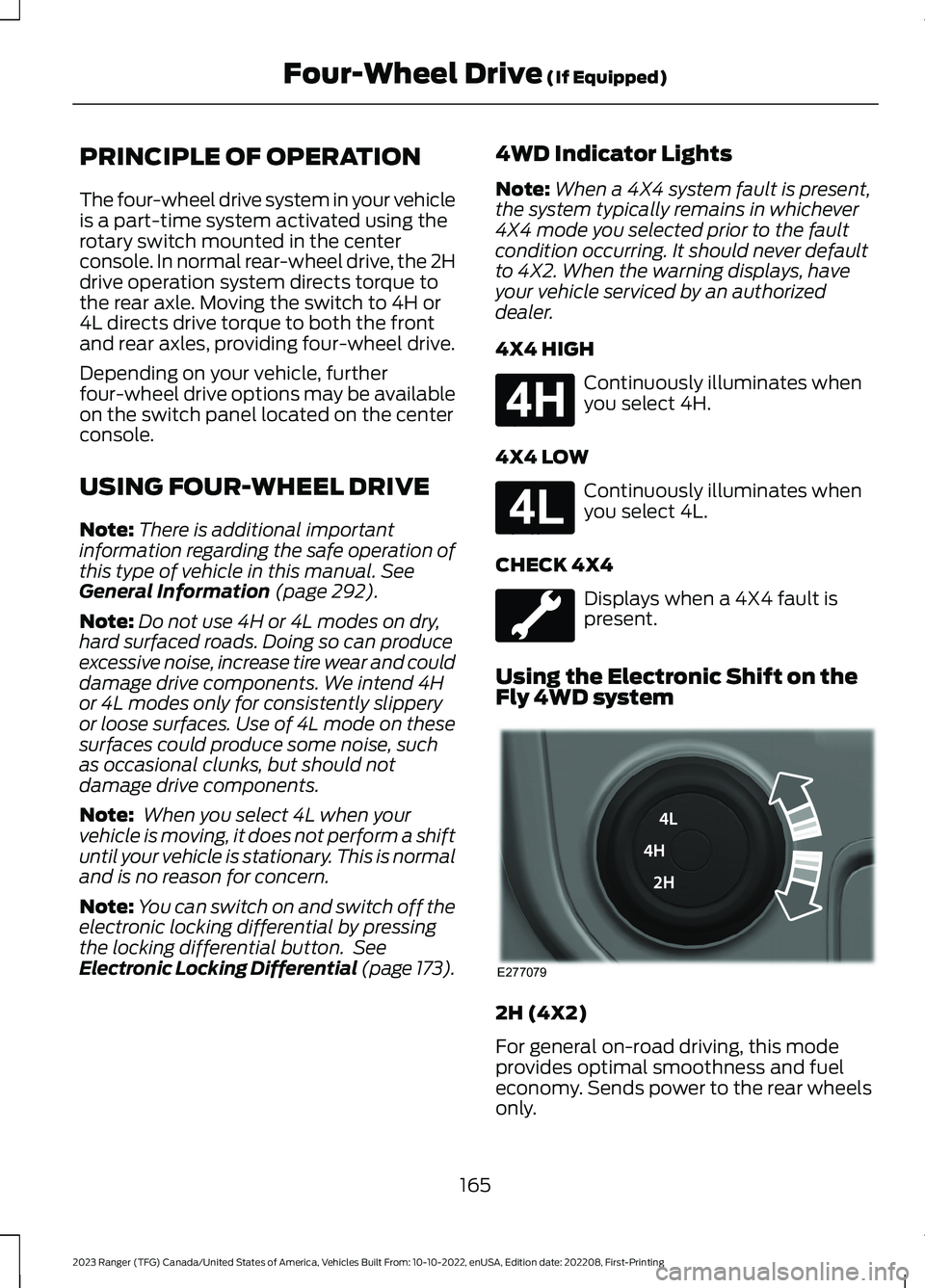
PRINCIPLE OF OPERATION
The four-wheel drive system in your vehicleis a part-time system activated using therotary switch mounted in the centerconsole. In normal rear-wheel drive, the 2Hdrive operation system directs torque tothe rear axle. Moving the switch to 4H or4L directs drive torque to both the frontand rear axles, providing four-wheel drive.
Depending on your vehicle, furtherfour-wheel drive options may be availableon the switch panel located on the centerconsole.
USING FOUR-WHEEL DRIVE
Note:There is additional importantinformation regarding the safe operation ofthis type of vehicle in this manual. SeeGeneral Information (page 292).
Note:Do not use 4H or 4L modes on dry,hard surfaced roads. Doing so can produceexcessive noise, increase tire wear and coulddamage drive components. We intend 4Hor 4L modes only for consistently slipperyor loose surfaces. Use of 4L mode on thesesurfaces could produce some noise, suchas occasional clunks, but should notdamage drive components.
Note: When you select 4L when yourvehicle is moving, it does not perform a shiftuntil your vehicle is stationary. This is normaland is no reason for concern.
Note:You can switch on and switch off theelectronic locking differential by pressingthe locking differential button. SeeElectronic Locking Differential (page 173).
4WD Indicator Lights
Note:When a 4X4 system fault is present,the system typically remains in whichever4X4 mode you selected prior to the faultcondition occurring. It should never defaultto 4X2. When the warning displays, haveyour vehicle serviced by an authorizeddealer.
4X4 HIGH
Continuously illuminates whenyou select 4H.
4X4 LOW
Continuously illuminates whenyou select 4L.
CHECK 4X4
Displays when a 4X4 fault ispresent.
Using the Electronic Shift on theFly 4WD system
2H (4X2)
For general on-road driving, this modeprovides optimal smoothness and fueleconomy. Sends power to the rear wheelsonly.
165
2023 Ranger (TFG) Canada/United States of America, Vehicles Built From: 10-10-2022, enUSA, Edition date: 202208, First-PrintingFour-Wheel Drive (If Equipped)E181779 E181780 E277079
Page 171 of 470
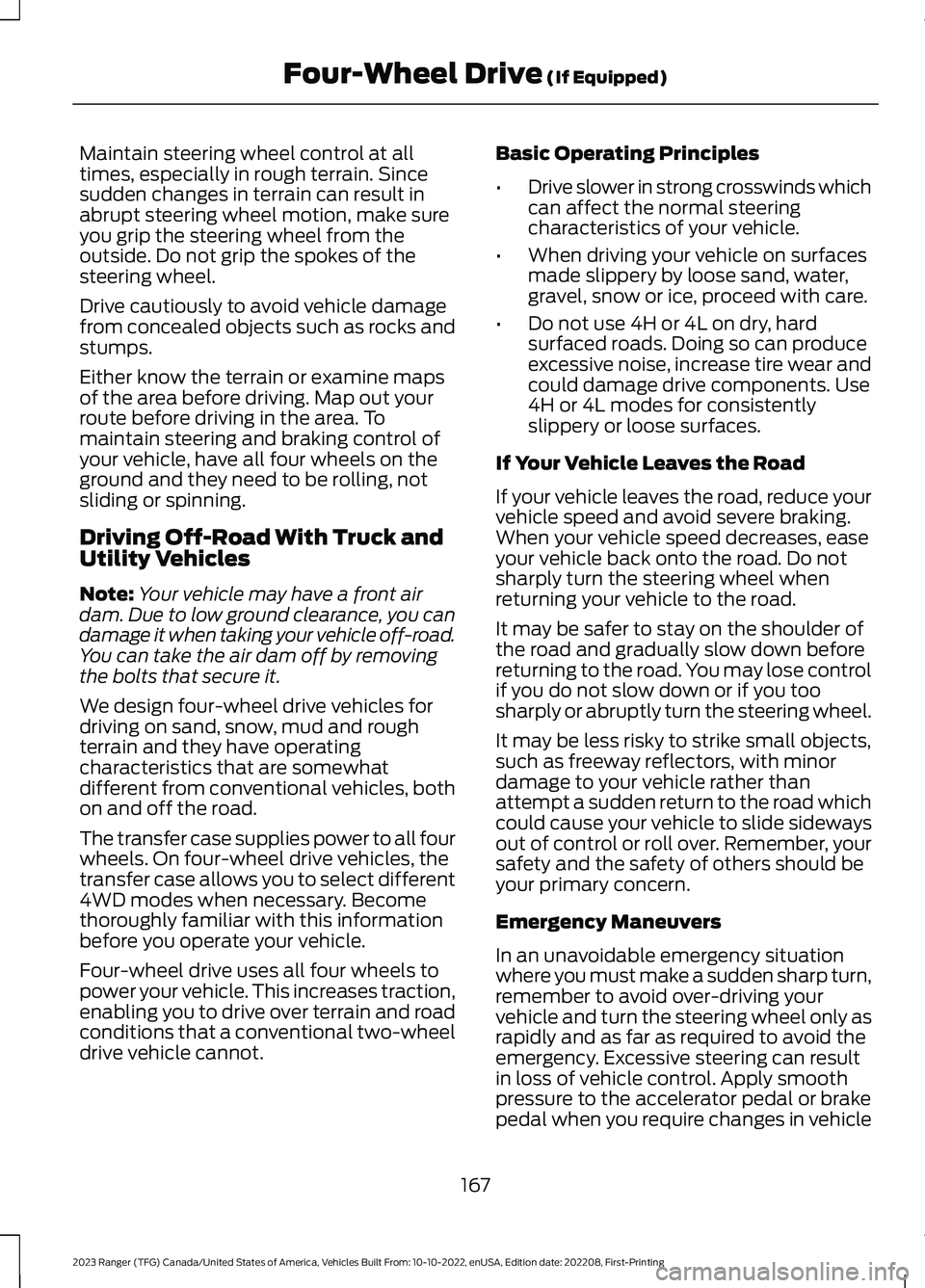
Maintain steering wheel control at alltimes, especially in rough terrain. Sincesudden changes in terrain can result inabrupt steering wheel motion, make sureyou grip the steering wheel from theoutside. Do not grip the spokes of thesteering wheel.
Drive cautiously to avoid vehicle damagefrom concealed objects such as rocks andstumps.
Either know the terrain or examine mapsof the area before driving. Map out yourroute before driving in the area. Tomaintain steering and braking control ofyour vehicle, have all four wheels on theground and they need to be rolling, notsliding or spinning.
Driving Off-Road With Truck andUtility Vehicles
Note:Your vehicle may have a front airdam. Due to low ground clearance, you candamage it when taking your vehicle off-road.You can take the air dam off by removingthe bolts that secure it.
We design four-wheel drive vehicles fordriving on sand, snow, mud and roughterrain and they have operatingcharacteristics that are somewhatdifferent from conventional vehicles, bothon and off the road.
The transfer case supplies power to all fourwheels. On four-wheel drive vehicles, thetransfer case allows you to select different4WD modes when necessary. Becomethoroughly familiar with this informationbefore you operate your vehicle.
Four-wheel drive uses all four wheels topower your vehicle. This increases traction,enabling you to drive over terrain and roadconditions that a conventional two-wheeldrive vehicle cannot.
Basic Operating Principles
•Drive slower in strong crosswinds whichcan affect the normal steeringcharacteristics of your vehicle.
•When driving your vehicle on surfacesmade slippery by loose sand, water,gravel, snow or ice, proceed with care.
•Do not use 4H or 4L on dry, hardsurfaced roads. Doing so can produceexcessive noise, increase tire wear andcould damage drive components. Use4H or 4L modes for consistentlyslippery or loose surfaces.
If Your Vehicle Leaves the Road
If your vehicle leaves the road, reduce yourvehicle speed and avoid severe braking.When your vehicle speed decreases, easeyour vehicle back onto the road. Do notsharply turn the steering wheel whenreturning your vehicle to the road.
It may be safer to stay on the shoulder ofthe road and gradually slow down beforereturning to the road. You may lose controlif you do not slow down or if you toosharply or abruptly turn the steering wheel.
It may be less risky to strike small objects,such as freeway reflectors, with minordamage to your vehicle rather thanattempt a sudden return to the road whichcould cause your vehicle to slide sidewaysout of control or roll over. Remember, yoursafety and the safety of others should beyour primary concern.
Emergency Maneuvers
In an unavoidable emergency situationwhere you must make a sudden sharp turn,remember to avoid over-driving yourvehicle and turn the steering wheel only asrapidly and as far as required to avoid theemergency. Excessive steering can resultin loss of vehicle control. Apply smoothpressure to the accelerator pedal or brakepedal when you require changes in vehicle
167
2023 Ranger (TFG) Canada/United States of America, Vehicles Built From: 10-10-2022, enUSA, Edition date: 202208, First-PrintingFour-Wheel Drive (If Equipped)
Page 172 of 470
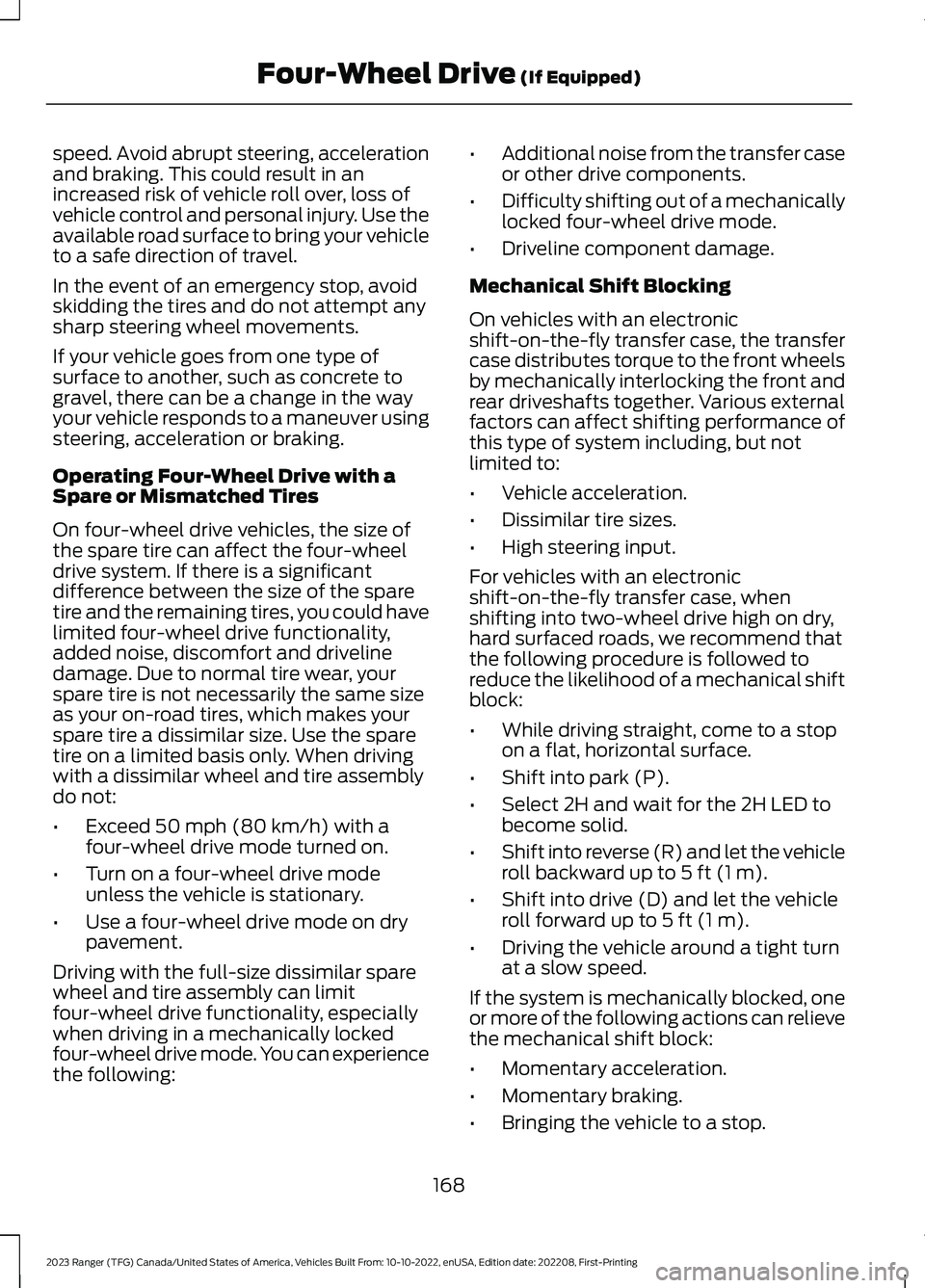
speed. Avoid abrupt steering, accelerationand braking. This could result in anincreased risk of vehicle roll over, loss ofvehicle control and personal injury. Use theavailable road surface to bring your vehicleto a safe direction of travel.
In the event of an emergency stop, avoidskidding the tires and do not attempt anysharp steering wheel movements.
If your vehicle goes from one type ofsurface to another, such as concrete togravel, there can be a change in the wayyour vehicle responds to a maneuver usingsteering, acceleration or braking.
Operating Four-Wheel Drive with aSpare or Mismatched Tires
On four-wheel drive vehicles, the size ofthe spare tire can affect the four-wheeldrive system. If there is a significantdifference between the size of the sparetire and the remaining tires, you could havelimited four-wheel drive functionality,added noise, discomfort and drivelinedamage. Due to normal tire wear, yourspare tire is not necessarily the same sizeas your on-road tires, which makes yourspare tire a dissimilar size. Use the sparetire on a limited basis only. When drivingwith a dissimilar wheel and tire assemblydo not:
•Exceed 50 mph (80 km/h) with afour-wheel drive mode turned on.
•Turn on a four-wheel drive modeunless the vehicle is stationary.
•Use a four-wheel drive mode on drypavement.
Driving with the full-size dissimilar sparewheel and tire assembly can limitfour-wheel drive functionality, especiallywhen driving in a mechanically lockedfour-wheel drive mode. You can experiencethe following:
•Additional noise from the transfer caseor other drive components.
•Difficulty shifting out of a mechanicallylocked four-wheel drive mode.
•Driveline component damage.
Mechanical Shift Blocking
On vehicles with an electronicshift-on-the-fly transfer case, the transfercase distributes torque to the front wheelsby mechanically interlocking the front andrear driveshafts together. Various externalfactors can affect shifting performance ofthis type of system including, but notlimited to:
•Vehicle acceleration.
•Dissimilar tire sizes.
•High steering input.
For vehicles with an electronicshift-on-the-fly transfer case, whenshifting into two-wheel drive high on dry,hard surfaced roads, we recommend thatthe following procedure is followed toreduce the likelihood of a mechanical shiftblock:
•While driving straight, come to a stopon a flat, horizontal surface.
•Shift into park (P).
•Select 2H and wait for the 2H LED tobecome solid.
•Shift into reverse (R) and let the vehicleroll backward up to 5 ft (1 m).
•Shift into drive (D) and let the vehicleroll forward up to 5 ft (1 m).
•Driving the vehicle around a tight turnat a slow speed.
If the system is mechanically blocked, oneor more of the following actions can relievethe mechanical shift block:
•Momentary acceleration.
•Momentary braking.
•Bringing the vehicle to a stop.
168
2023 Ranger (TFG) Canada/United States of America, Vehicles Built From: 10-10-2022, enUSA, Edition date: 202208, First-PrintingFour-Wheel Drive (If Equipped)
Page 177 of 470
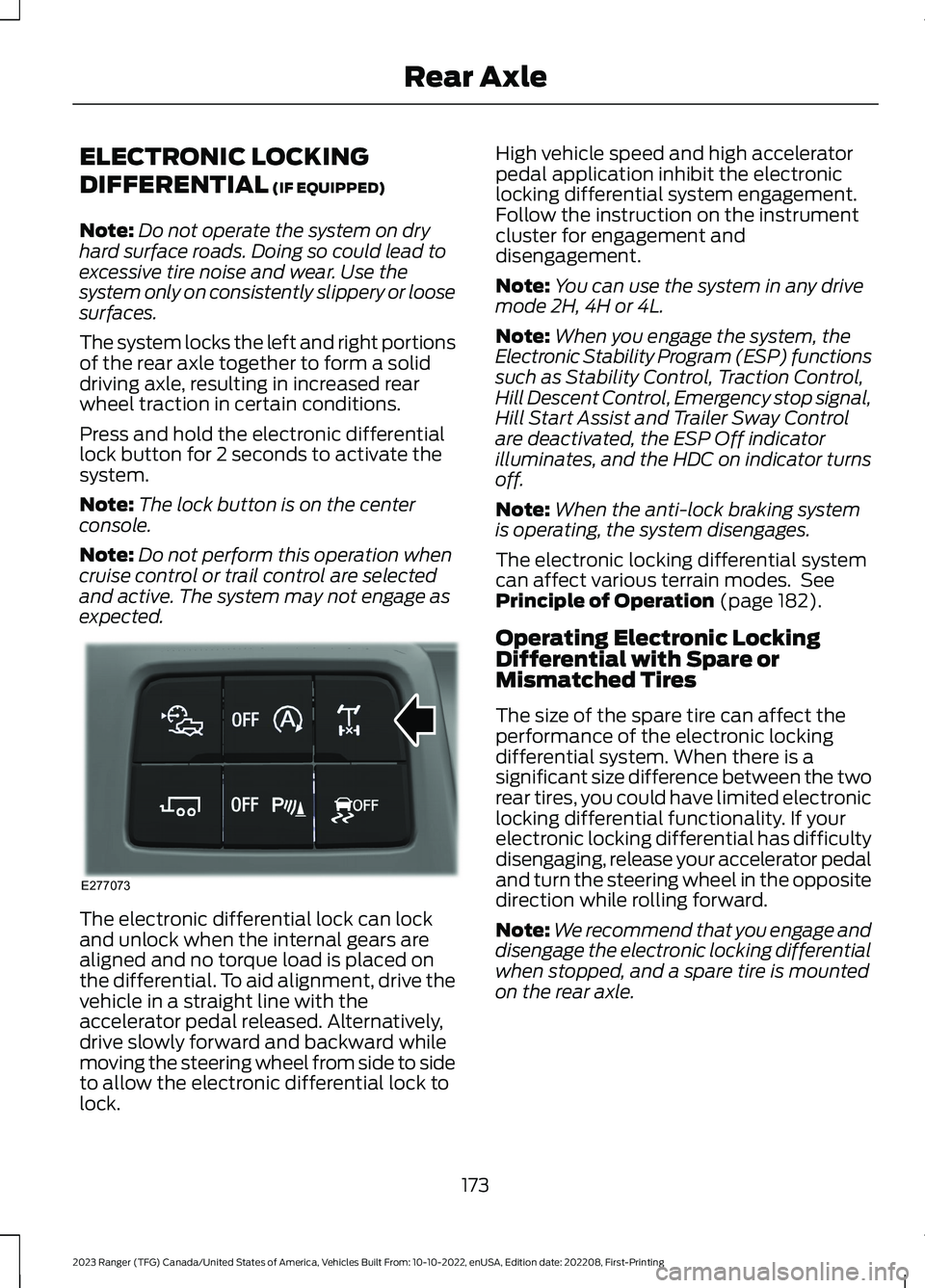
ELECTRONIC LOCKING
DIFFERENTIAL (IF EQUIPPED)
Note:Do not operate the system on dryhard surface roads. Doing so could lead toexcessive tire noise and wear. Use thesystem only on consistently slippery or loosesurfaces.
The system locks the left and right portionsof the rear axle together to form a soliddriving axle, resulting in increased rearwheel traction in certain conditions.
Press and hold the electronic differentiallock button for 2 seconds to activate thesystem.
Note:The lock button is on the centerconsole.
Note:Do not perform this operation whencruise control or trail control are selectedand active. The system may not engage asexpected.
The electronic differential lock can lockand unlock when the internal gears arealigned and no torque load is placed onthe differential. To aid alignment, drive thevehicle in a straight line with theaccelerator pedal released. Alternatively,drive slowly forward and backward whilemoving the steering wheel from side to sideto allow the electronic differential lock tolock.
High vehicle speed and high acceleratorpedal application inhibit the electroniclocking differential system engagement.Follow the instruction on the instrumentcluster for engagement anddisengagement.
Note:You can use the system in any drivemode 2H, 4H or 4L.
Note:When you engage the system, theElectronic Stability Program (ESP) functionssuch as Stability Control, Traction Control,Hill Descent Control, Emergency stop signal,Hill Start Assist and Trailer Sway Controlare deactivated, the ESP Off indicatorilluminates, and the HDC on indicator turnsoff.
Note:When the anti-lock braking systemis operating, the system disengages.
The electronic locking differential systemcan affect various terrain modes. SeePrinciple of Operation (page 182).
Operating Electronic LockingDifferential with Spare orMismatched Tires
The size of the spare tire can affect theperformance of the electronic lockingdifferential system. When there is asignificant size difference between the tworear tires, you could have limited electroniclocking differential functionality. If yourelectronic locking differential has difficultydisengaging, release your accelerator pedaland turn the steering wheel in the oppositedirection while rolling forward.
Note:We recommend that you engage anddisengage the electronic locking differentialwhen stopped, and a spare tire is mountedon the rear axle.
173
2023 Ranger (TFG) Canada/United States of America, Vehicles Built From: 10-10-2022, enUSA, Edition date: 202208, First-PrintingRear AxleE277073
Page 182 of 470
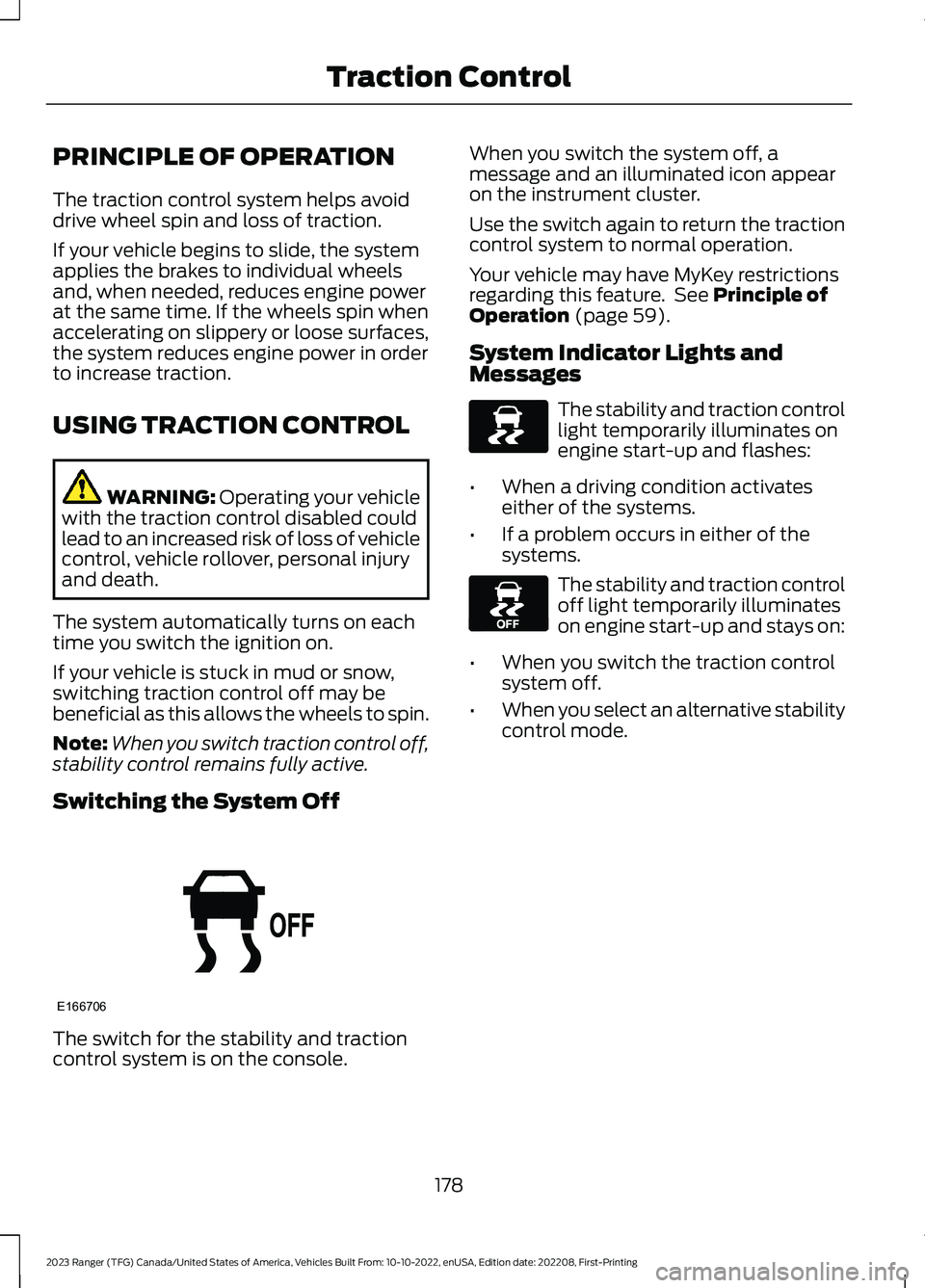
PRINCIPLE OF OPERATION
The traction control system helps avoiddrive wheel spin and loss of traction.
If your vehicle begins to slide, the systemapplies the brakes to individual wheelsand, when needed, reduces engine powerat the same time. If the wheels spin whenaccelerating on slippery or loose surfaces,the system reduces engine power in orderto increase traction.
USING TRACTION CONTROL
WARNING: Operating your vehiclewith the traction control disabled couldlead to an increased risk of loss of vehiclecontrol, vehicle rollover, personal injuryand death.
The system automatically turns on eachtime you switch the ignition on.
If your vehicle is stuck in mud or snow,switching traction control off may bebeneficial as this allows the wheels to spin.
Note:When you switch traction control off,stability control remains fully active.
Switching the System Off
The switch for the stability and tractioncontrol system is on the console.
When you switch the system off, amessage and an illuminated icon appearon the instrument cluster.
Use the switch again to return the tractioncontrol system to normal operation.
Your vehicle may have MyKey restrictionsregarding this feature. See Principle ofOperation (page 59).
System Indicator Lights andMessages
The stability and traction controllight temporarily illuminates onengine start-up and flashes:
•When a driving condition activateseither of the systems.
•If a problem occurs in either of thesystems.
The stability and traction controloff light temporarily illuminateson engine start-up and stays on:
•When you switch the traction controlsystem off.
•When you select an alternative stabilitycontrol mode.
178
2023 Ranger (TFG) Canada/United States of America, Vehicles Built From: 10-10-2022, enUSA, Edition date: 202208, First-PrintingTraction ControlE166706 E138639 E130458
Page 186 of 470
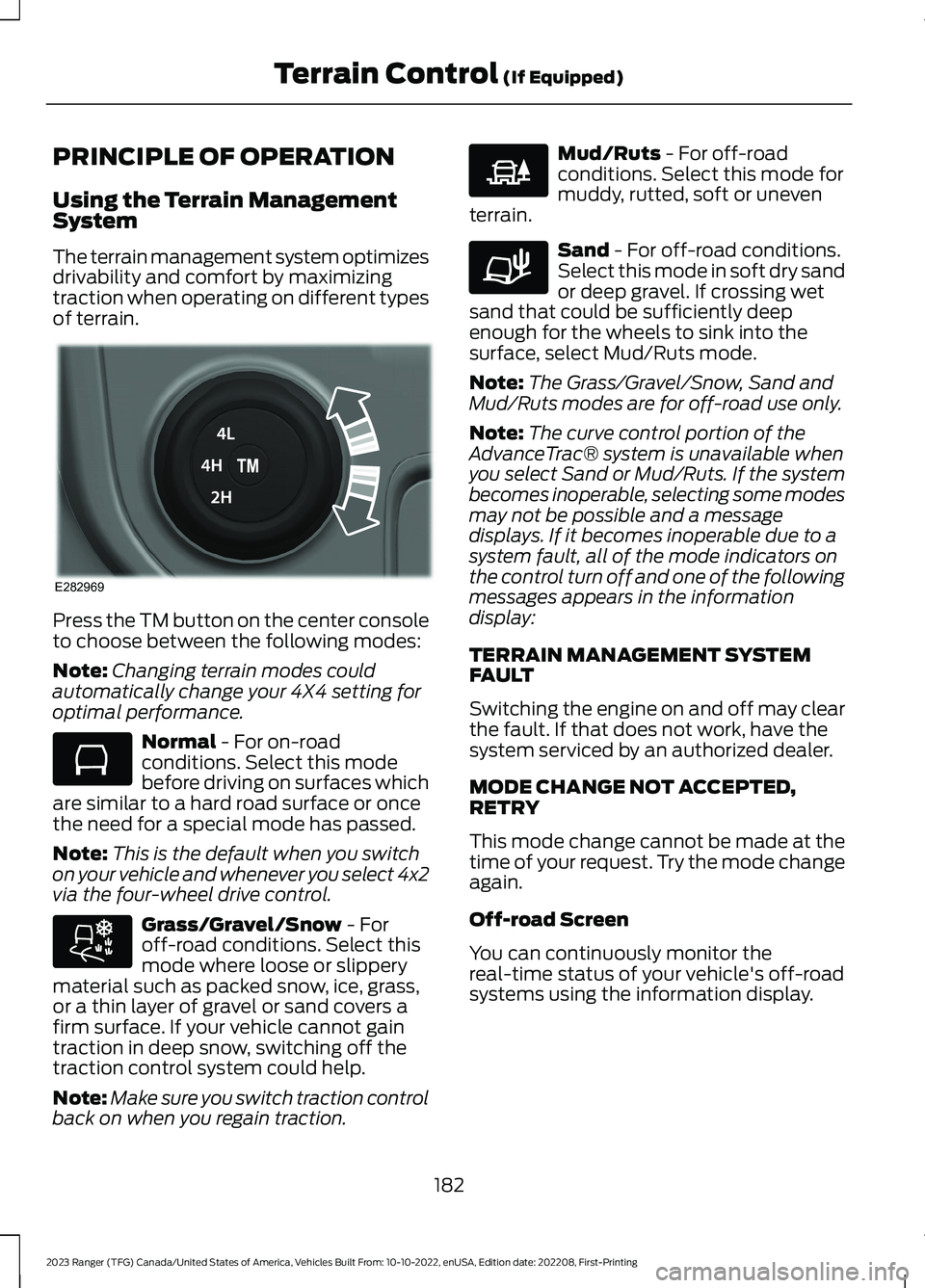
PRINCIPLE OF OPERATION
Using the Terrain ManagementSystem
The terrain management system optimizesdrivability and comfort by maximizingtraction when operating on different typesof terrain.
Press the TM button on the center consoleto choose between the following modes:
Note:Changing terrain modes couldautomatically change your 4X4 setting foroptimal performance.
Normal - For on-roadconditions. Select this modebefore driving on surfaces whichare similar to a hard road surface or oncethe need for a special mode has passed.
Note:This is the default when you switchon your vehicle and whenever you select 4x2via the four-wheel drive control.
Grass/Gravel/Snow - Foroff-road conditions. Select thismode where loose or slipperymaterial such as packed snow, ice, grass,or a thin layer of gravel or sand covers afirm surface. If your vehicle cannot gaintraction in deep snow, switching off thetraction control system could help.
Note:Make sure you switch traction controlback on when you regain traction.
Mud/Ruts - For off-roadconditions. Select this mode formuddy, rutted, soft or uneventerrain.
Sand - For off-road conditions.Select this mode in soft dry sandor deep gravel. If crossing wetsand that could be sufficiently deepenough for the wheels to sink into thesurface, select Mud/Ruts mode.
Note:The Grass/Gravel/Snow, Sand andMud/Ruts modes are for off-road use only.
Note:The curve control portion of theAdvanceTrac® system is unavailable whenyou select Sand or Mud/Ruts. If the systembecomes inoperable, selecting some modesmay not be possible and a messagedisplays. If it becomes inoperable due to asystem fault, all of the mode indicators onthe control turn off and one of the followingmessages appears in the informationdisplay:
TERRAIN MANAGEMENT SYSTEMFAULT
Switching the engine on and off may clearthe fault. If that does not work, have thesystem serviced by an authorized dealer.
MODE CHANGE NOT ACCEPTED,RETRY
This mode change cannot be made at thetime of your request. Try the mode changeagain.
Off-road Screen
You can continuously monitor thereal-time status of your vehicle's off-roadsystems using the information display.
182
2023 Ranger (TFG) Canada/United States of America, Vehicles Built From: 10-10-2022, enUSA, Edition date: 202208, First-PrintingTerrain Control (If Equipped)E282969 E283048 E283044 E225313 E283037
Page 187 of 470
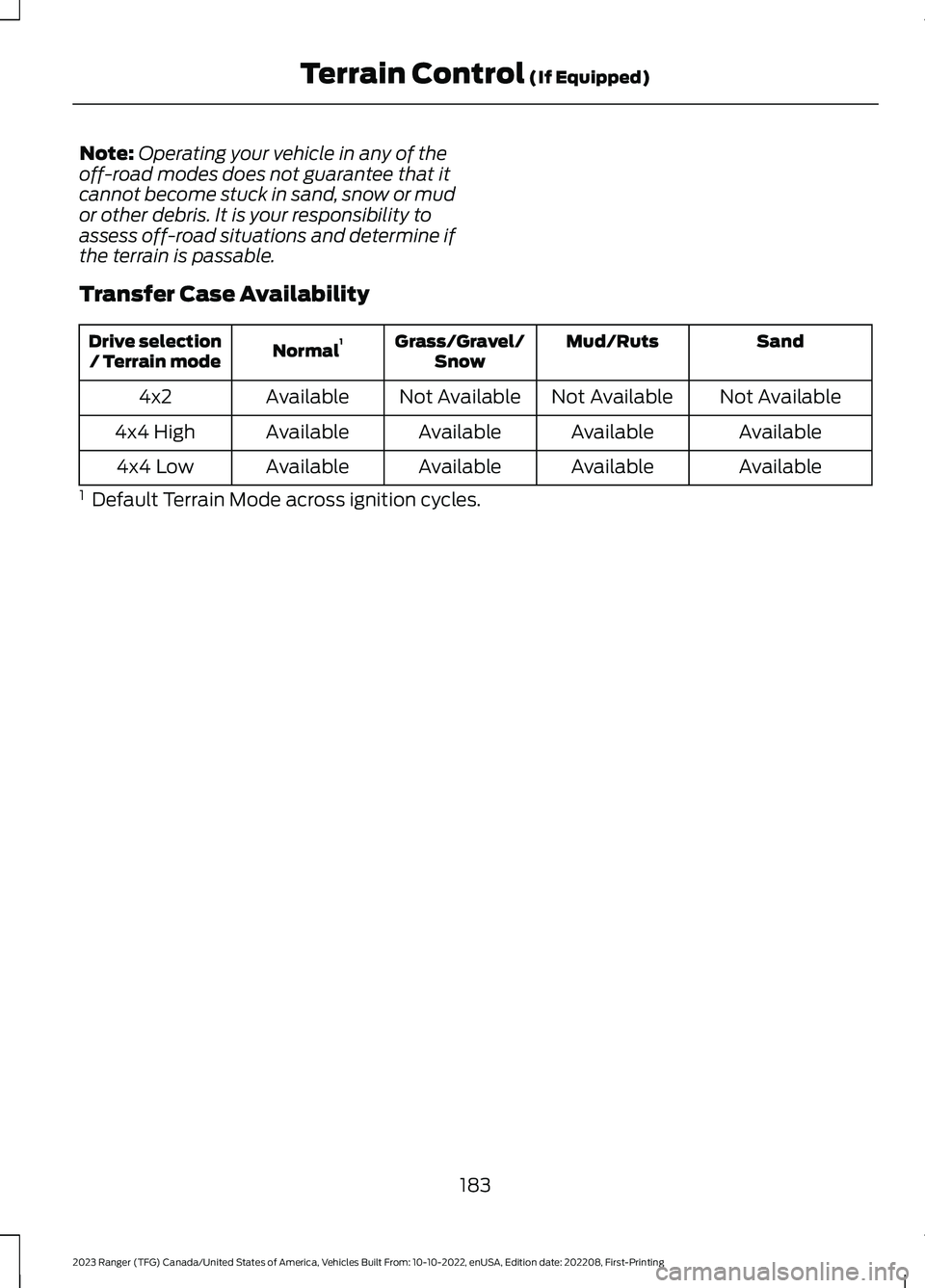
Note:Operating your vehicle in any of theoff-road modes does not guarantee that itcannot become stuck in sand, snow or mudor other debris. It is your responsibility toassess off-road situations and determine ifthe terrain is passable.
Transfer Case Availability
SandMud/RutsGrass/Gravel/SnowNormal1Drive selection/ Terrain mode
Not AvailableNot AvailableNot AvailableAvailable4x2
AvailableAvailableAvailableAvailable4x4 High
AvailableAvailableAvailableAvailable4x4 Low
1 Default Terrain Mode across ignition cycles.
183
2023 Ranger (TFG) Canada/United States of America, Vehicles Built From: 10-10-2022, enUSA, Edition date: 202208, First-PrintingTerrain Control (If Equipped)
Page 197 of 470
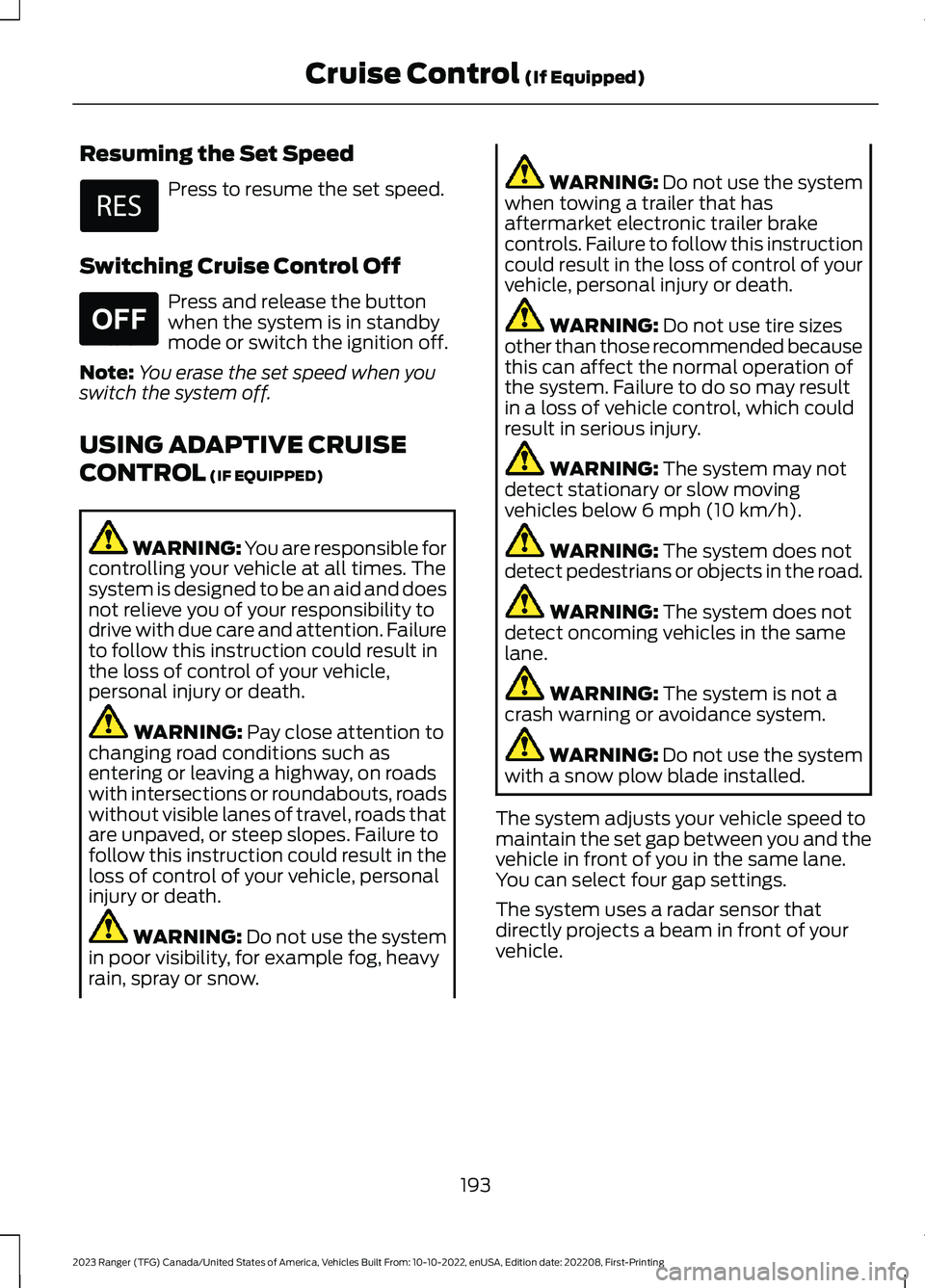
Resuming the Set Speed
Press to resume the set speed.
Switching Cruise Control Off
Press and release the buttonwhen the system is in standbymode or switch the ignition off.
Note:You erase the set speed when youswitch the system off.
USING ADAPTIVE CRUISE
CONTROL (IF EQUIPPED)
WARNING: You are responsible forcontrolling your vehicle at all times. Thesystem is designed to be an aid and doesnot relieve you of your responsibility todrive with due care and attention. Failureto follow this instruction could result inthe loss of control of your vehicle,personal injury or death.
WARNING: Pay close attention tochanging road conditions such asentering or leaving a highway, on roadswith intersections or roundabouts, roadswithout visible lanes of travel, roads thatare unpaved, or steep slopes. Failure tofollow this instruction could result in theloss of control of your vehicle, personalinjury or death.
WARNING: Do not use the systemin poor visibility, for example fog, heavyrain, spray or snow.
WARNING: Do not use the systemwhen towing a trailer that hasaftermarket electronic trailer brakecontrols. Failure to follow this instructioncould result in the loss of control of yourvehicle, personal injury or death.
WARNING: Do not use tire sizesother than those recommended becausethis can affect the normal operation ofthe system. Failure to do so may resultin a loss of vehicle control, which couldresult in serious injury.
WARNING: The system may notdetect stationary or slow movingvehicles below 6 mph (10 km/h).
WARNING: The system does notdetect pedestrians or objects in the road.
WARNING: The system does notdetect oncoming vehicles in the samelane.
WARNING: The system is not acrash warning or avoidance system.
WARNING: Do not use the systemwith a snow plow blade installed.
The system adjusts your vehicle speed tomaintain the set gap between you and thevehicle in front of you in the same lane.You can select four gap settings.
The system uses a radar sensor thatdirectly projects a beam in front of yourvehicle.
193
2023 Ranger (TFG) Canada/United States of America, Vehicles Built From: 10-10-2022, enUSA, Edition date: 202208, First-PrintingCruise Control (If Equipped) E265297
Page 203 of 470
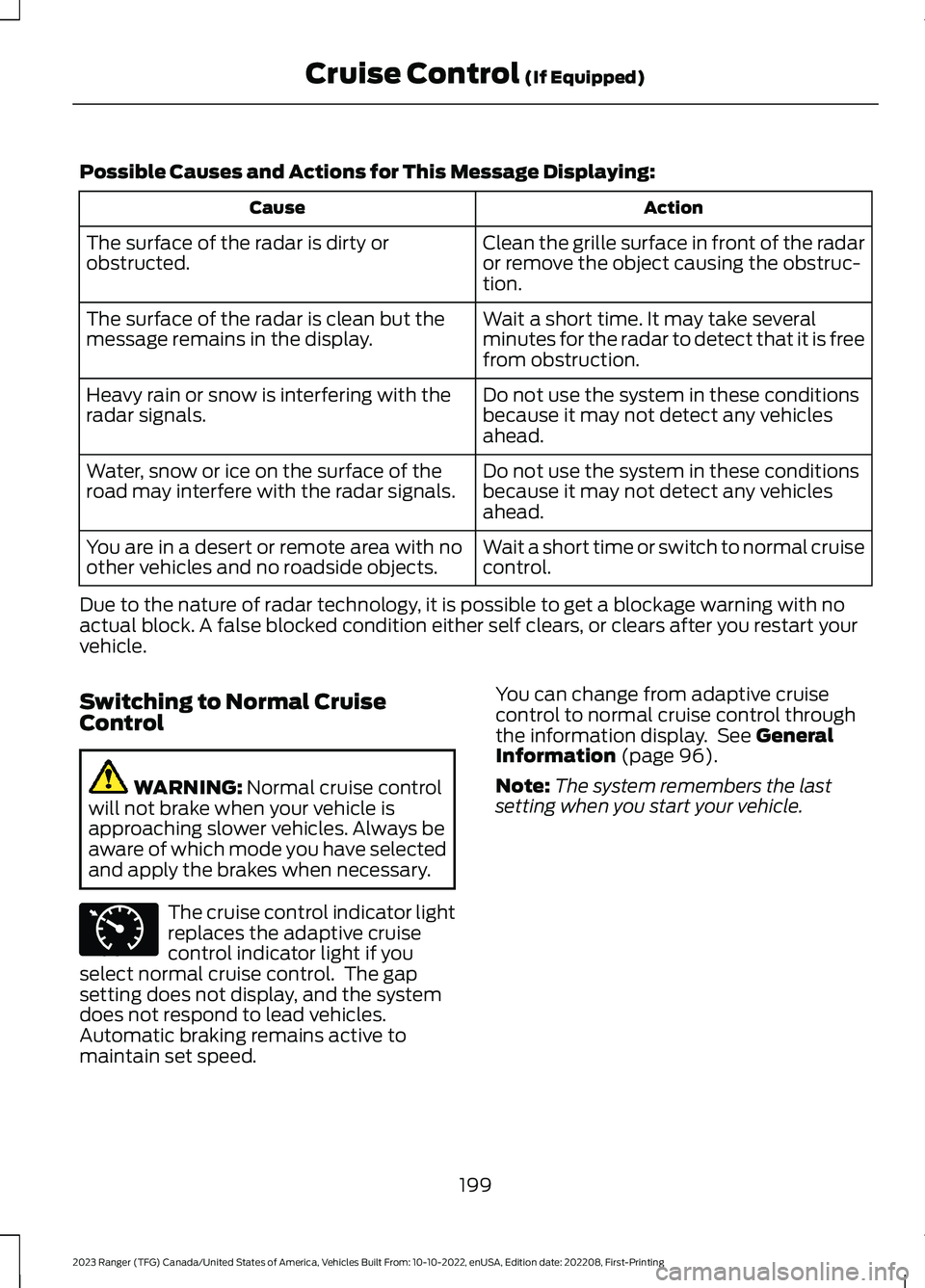
Possible Causes and Actions for This Message Displaying:
ActionCause
Clean the grille surface in front of the radaror remove the object causing the obstruc-tion.
The surface of the radar is dirty orobstructed.
Wait a short time. It may take severalminutes for the radar to detect that it is freefrom obstruction.
The surface of the radar is clean but themessage remains in the display.
Do not use the system in these conditionsbecause it may not detect any vehiclesahead.
Heavy rain or snow is interfering with theradar signals.
Do not use the system in these conditionsbecause it may not detect any vehiclesahead.
Water, snow or ice on the surface of theroad may interfere with the radar signals.
Wait a short time or switch to normal cruisecontrol.You are in a desert or remote area with noother vehicles and no roadside objects.
Due to the nature of radar technology, it is possible to get a blockage warning with noactual block. A false blocked condition either self clears, or clears after you restart yourvehicle.
Switching to Normal CruiseControl
WARNING: Normal cruise controlwill not brake when your vehicle isapproaching slower vehicles. Always beaware of which mode you have selectedand apply the brakes when necessary.
The cruise control indicator lightreplaces the adaptive cruisecontrol indicator light if youselect normal cruise control. The gapsetting does not display, and the systemdoes not respond to lead vehicles.Automatic braking remains active tomaintain set speed.
You can change from adaptive cruisecontrol to normal cruise control throughthe information display. See GeneralInformation (page 96).
Note:The system remembers the lastsetting when you start your vehicle.
199
2023 Ranger (TFG) Canada/United States of America, Vehicles Built From: 10-10-2022, enUSA, Edition date: 202208, First-PrintingCruise Control (If Equipped)E71340